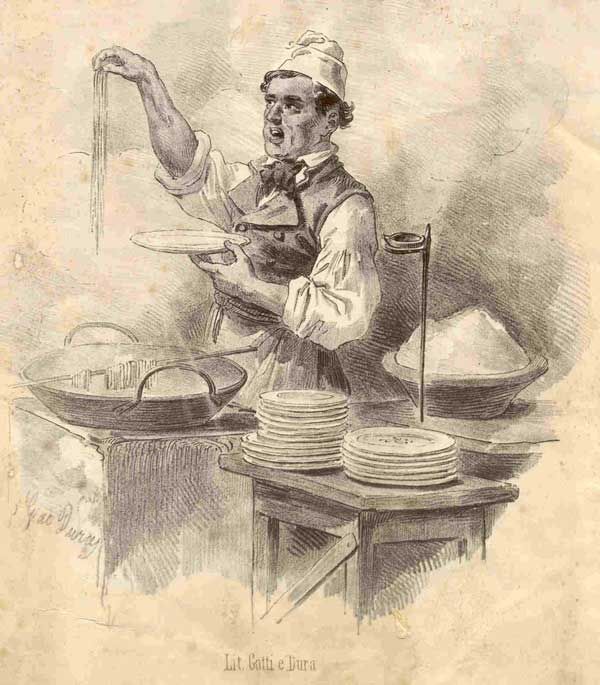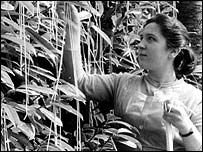|
|||||
|
|||||||
|
    An initiative of :Stichting Food-Info
|
| Food-Info.net> Products > Pasta History of Italian-type pasta.The use of pasta seems to have started among specific populations in certain areas and later spread to the whole world. The oldest use of pasta probably dates from China, where it is still used widely today. Chinese and Asian pasta, however, is generally referred to as noodles. Greeks and RomansMany sources claim that Marco Polo introduced pasta from his Asian travels to Italy in 1292 AD, but the origins of 'macaroni' in Italy go back as far as the time of the Ancient Romans who gave the credit to the 'Gods'. A common legend states that pasta was invented by the Greek God of fire, Hephaestus (Vulcanus for the Romans), but this is nowhere mentioned in classical literature. Pasta undoubtedly was known to both the ancient Greeks and Romans. One specific type was a broad noodle called in Greek 'laganon', probably similar to present-day lasagna. It is significant, however, that this was not boiled as we boil lasagna, but roasted on hot stones or in ovens; more related to what we would now think of as pizza. Apicius, a Roman writer of the first century AD describes a pasta made "to enclose timballi and pies..." These were called "lagana.' The recipe for the dough is not given, however there are suggestions for layering and seasoning with meat and fish. This would be similar to present day ravioli or tortellini. There are also speculations that pasta in some kind was already used by the Etruscans, but there is no real historical evidence for this. The Arabs and pastaThe first certain record of noodles cooked by boiling is in the Jerusalem Talmud, written in Aramaic in the 5th century AD. The word used for the noodles was itriyah. In Arabic references this word stands for the dried noodles purchased from a vendor, rather than homemade noodles which would have been fresh. Dried noodles are portable, while fresh must be eaten immediately. More than likely, pasta was introduced during the Arab conquests of Sicily, carried in as a dry staple. The Arab geographer, Al Idrisi wrote that a flour-based product in the shape of strings was produced in Palermo, then an Arab colony. It is speculated that the Sicilian word "maccaruni" which translates as "made into a dough by force" is the origin of the word macaroni. In the ancient methods of making pasta, force meant kneading the dough with the feet, often a process that took a full day. Ancient Sicilian lasagna dishes, some still eaten in Sicily today, included raisins and spices brought by the Arab invaders, another indication that the Arabs introduced pasta (back) to what is now Italy. Medieval ItalyAround the year 1000, we have the first documented recipe for pasta in the book "De arte Coquinaria per vermicelli e macaroni siciliani", (The Art of Cooking Sicilian Macaroni and Vermicelli) written by Martino Corno, chef to the powerful Patriarch of Aquileia. The first historical sources referring to the production of dried pasta in what seems like a small-scale industrial enterprise date from 1150 when the Arab geographer Al-Idrisi reports that at Trabia, about 30 km. from Palermo, "they produce an abundance of pasta in the shape of strings ("tria" in Arabic) which are exported everywhere, in Calabria and in many Muslim and Christian countries, even by ship." In 1279 a Genoese soldier listed in the inventory of his estate a basket of dried pasta ('una bariscella plena de macaronis'). A document from 1244 and another from 1316 testify to the production of dried pasta in Liguria, indicating that pasta was now common all over the Italian peninsula. Between 1400 and 1500, the production by craftsmen of "fidei" (pasta in the local dialect) became quite widespread in Liguria, as demonstrated by the founding of the Corporation of Pasta-Makers in 1546 (the oldest surviving document of this guild, however, dates from 1571) in Naples. In 1574 a similar guild was founded in Genoa, three years later, the "Regolazione dell'Arte dei Maestri Fidelari" (Rules for the Pasta-Masters' Art Corporation) were drawn up in Savona. In 1584, the author Giordano Bruno quotes a Neapolitan saying, " è cascato il maccarone dentro il formaggio " (the maccherone has fallen into the cheese). Various types of pasta, including long hollow tubes, are mentioned in the 15th century records of Italian and Dominican monasteries. By the 17th century, pasta had become part of the daily diet throughout Italy because it was economical, readily available and versatile. 17th and 18thcenturyIn the 17th century, especially in Naples, population growth was aggravating the problems of food accessibility, until a small technological revolution made it possible to produce pasta at a much lower price. Pasta thus became the food of the people. Naples 's vicinity to the sea (as was the case of Liguria and Sicily) facilitated drying, a process which allowed pasta to be conserved for an extended period of time. The harbour facilities also made it possible to export the new dried pasta all over Italy. Previously, pasta was made by mixing semolina dough by foot. The pasta maker sat on a long bench and used his feet to mix and knead the dough. The king of Naples, Ferdinando II, hired a famous engineer (Cesare Spadaccini) to improve the procedure. The new system consisted of adding boiling water to freshly-ground flour, and kneading by foot was replaced by a machine made of bronze that perfectly imitated the work done by man. In 1740, the city of Venice issued Paolo Adami a license to open the first pasta factory. The machinery was simple enough. It consisted of an iron press, powered by several young boys. In 1763, the Duke of Parma, Don Ferdinando of Bourbon, gave Stefano Lucciardi of Sarzana the right to a 10 year-monopoly for the production of dried pasta - "Genoa-style" - in the city of Parma. In 1766 the corpse of Saint Stephen is found in a kneading-trough where he had been buried. For this reason he becomes the protector saint of pasta makers. In his diary, Travels in Italy (from 1787), Goethe defines maccheroni as "a delicate pasta, made with fine semolina, heavily worked, boiled and cut into various shapes".
 19th century pasta seller (Source) TomatoesUntil the end of the 18th century pasta had been eaten without seasoning or with cheese. The first mention of using tomato dated back to the 17th century. It was imported into Spain from the New World, and later spread throughout Europe, finding an ideal climate for cultivation in the Mediterranean countries. But tomato didn't become a common ingredient in Italian cooking until the end of the 18th century. At first, the tomato was considered an ornamental plant, and believed to be poisonous (the plant is, the fruit, the tomato, is not). In 1778 Vincenzo Corrado mentioned in his cooking book "Cuoco galante" (The Gentlemen's Chef) a tomato sauce, but not to season pasta. Tomato sauce, boiled in a pot with a pinch of salt and a few basil leaves, was used beginning in the early 1800's by open-air vendors in the south of Italy for seasoning macaroni. And pizza began to be seasoned with tomato sauce and mozzarella only in the mid 19th century. IndustrialisationSeveral pasta makers from the town of Amalfi opened a true industry of pasta at Torre Anunziata in Napels in the mid 19th century. It used water mills and grinding stones, and the semolina was separated from the bran using hand-held sieves. Machines brought with them market development, competition and export across the ocean, where many Italians had settled in America. In 1878, a machine destined to improve semolina - and therefore pasta - was introduced: the Marseillais purifier, invented at Marseille in France. The perforated leather which had been used in manual sieves was applied to mechanical shakers. The first hydraulic press was made in 1882 and the first steam-powered mill was used in 1884. New techniques made it possible to make absolutely perfect holes in the bronze disk that closed the pasta press (the die). This made the new industries realize that they could shake up the market (and improve market share) by changing the dies and inventing new, imaginative shapes. Already at the end of the 19th century a typical pasta factory offered an assortment that ranged from 150 to 200 different shapes. The pasta industry grew rapidly at the end of the 19th and early 20th century, shipping pasta worldwide. The wheat most beloved by pasta makers was the Taganrog variety, high quality durum wheat imported from Russia. The port of Taganrog, in Russia, shipped off the wheat that the Ligurian and Neapolitan pasta-makers preferred. An old brochure for a Ligurian pasta factory - at a time in which half of its production was destined for the state of New York alone - talks about "Pasta of Taganrog."
 Spaghetti (at the time called macaroni) drying in the street of Naples. (Source) 20th centuryThe great development of Italian pasta at the turn of the century was also tied to export, which in 1913 touched a record high of 70,000 tons, most of which was directed towards the United States. Later, importing countries began to produce at home, and Italian-built pasta-making machinery soon conquered the world. In 1917, Fereol Sandragne patented the first system for continuous pasta production. Meanwhile, the Bolshevik revolution had cut off imports of Russian wheat. Italian pasta producers first turned to French and American wheat, but nowadays most wheat for Italian pasta is homegrown in Italy, with some imports from Australia. In 1933 the first truly "continuos", fully automatic press is put into action. It was designed and built by two engineers from Parma, Mario and Giuseppe Braibanti. Nowadays pasta is widely used in Europe, Australia, North and South America. The main types are simple macaroni and spaghetti, but other types are widely available. The largest variety of pasta shapes, however, is still found in Italy.
 (Source) Spaghetti trees ?In 1957 the BBC televises a short film titled Spaghetti Picking in the Spring, illustrating country life in the countryside outside of Lugano. A very serious speaker describes the tree from which dozens of kilos of spaghetti hang.
 Source : BBC Some internet sources :
|
|
| ||
| Food-Info.net is an initiative of Stichting Food-Info, The Netherlands | ||||||